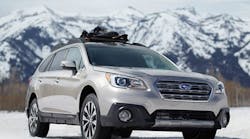Peaking demand, sky-high sales incentive costs, threats of a border tax -- none of these are distracting Subaru from its marketing and growth ambitions in its biggest market.
“America is the pillar,” Yasuyuki Yoshinaga, CEO of Fuji Heavy Industries Ltd., which owns the Subaru brand, said in an interview on March 8. “It’s true we want to increase sales in other countries, but in terms of the place with the best chance to increase sales, it has to be America’s sunbelt” states in the south.
The company, which will change its name to Subaru Corp. from April 1, already gets in excess of 60% of its sales from the U.S., something Yoshinaga readily admits is a “poor balance.” But he argues that Subaru must harness the brand power it has cultivated in the U.S., rather than divert its resources to cheaper, margin-eroding products for emerging markets. That’s something that a small automaker like Subaru can ill afford, given the increasing investments required to develop clean-energy and autonomous-driving technologies.
To survive alone, “there’s no other way for us than” to concentrate on the U.S., he said.
Subaru is connecting with U.S. car buyers both with its product lineup and unorthodox marketing strategy. Sales growth is being powered by its Outback crossover and refreshed Impreza compact. The brand has also created buzz with witty, socially conscious ads that target outdoor enthusiasts and millennials.
Waning Demand
Yoshinaga expects to sell 670,000-plus Subaru vehicles in the U.S. this year, a 9% increase from the 615,000 clocked in 2016, which was an eighth consecutive annual record. The 63-year-old says he’s not worried about a decline in demand, even as many automakers beef up incentives in a market that IHS Markit, CLSA Ltd., and J.D. Power, among others, warn may have already peaked. IHS, for example, sees total light vehicle sales dropping to 17.4 million units this year in the U.S., from 2016’s unprecedented 17.6 million.
The Subaru executive isn’t sweating it. “I don’t get the sense demand is going to fall sharply,” he said. “And if it doesn’t increase more than this, isn’t that fine too? It’s already at a record.”
Shinkin Asset Management Co. likes Subaru’s strategy. “The U.S. economic outlook isn’t going to be rosy forever, and the risk of not diversifying could emerge at some point, but for right now a bet on America seems like the right one,” said Naoki Fujiwara, the firm’s Tokyo-based chief fund manager, who doesn’t own Fuji Heavy shares.
What concerns Subaru more is the potential for a tax as high as 35%t on imported autos, as President Donald Trump tries to keep factory jobs in America. The automaker is among the most exposed, needing to ship about 40% of vehicles from Japan to meet this year’s sales target, even after booting top-shareholder Toyota Motor Corp. out of its Indiana plant to manufacture more of its own Outback, Impreza and Legacy models.
Despite that, Yoshinaga has no immediate plans to build more U.S. factories, partly because it takes years to add a new production line, meaning Subaru would likely still need to import vehicles that would be subject to any border levy.
Indiana Plant
Instead, Yoshinaga plans to wait until the Trump administration actually makes a decision -- and after that, he says his first line of defense will be to emphasize how much they’ve already increased capacity at their only plant outside Japan. The Indiana facility happens to be in the home state of Vice President Mike Pence, who’s been put in charge of trade issues with Japan.
Should that fail, Yoshinaga says there’s plenty of additional land at the Indiana site to expand if need be.
Trump aside, the immediate challenge for Subaru in the U.S. will be how to take an all-four-wheel-drive lineup that’s done well in the snowy north, and promote it in the south. In 16 southern states that include Florida, Missouri and Kentucky, but not California, Subaru has just 1.8% of the market, according to IHS data. In the rest of the country, the share is 4.7%.
Yoshinaga doesn’t plan to add many more dealerships, as the 630 already in the country have plenty of room to sell more Subarus. Instead he’ll rely on the brand image he’s tried to cultivate over the years: safe vehicles that are fun to drive.
He also signaled he’ll continue to avoid the rebates and cash incentives offered by some other automakers. Subaru only offers zero percent loans for Outback, Legacy and Forester models.
Even so, the company projects those sweeteners could increase costs per vehicle to $1,650 in the current quarter. Those costs would rise further as the Federal Reserve raises interest rates, and it will be extremely hard for Subaru to curb incentives unless other carmakers do the same, according to Yoshinaga.
Subaru’s average incentive of $950 per vehicle in February was more than 70% higher than a year earlier, although it was still the lowest in an industry that averaged $3,594, according to Autodata Corp.
Modest spending on incentives helped Subaru post an industry-leading operating profit margin of 11.6% in the quarter through December, according to data compiled by Bloomberg. Yoshinaga aims to keep it above 10%.
“We’re building a valuable car, and beyond that it’s a question of whether we can lift our brand image,” he said. “We want to be a company that delivers value to people’s lives as drivers. It’s not just about the vehicles.”
By Kevin Buckland, Yuki Hagiwara and Emi Nobuhiro




